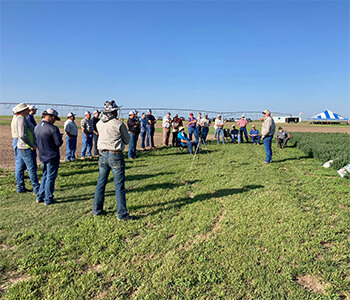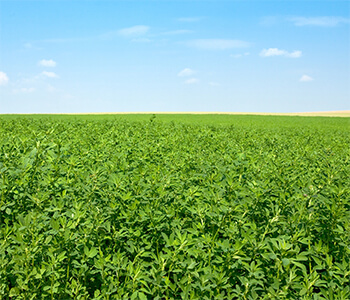A Deep Dive into Forages
Blog written by Jared Miller, MKC District Seed Sales Manager
Croplan Forage Field Days was recently held in Garden City, Kansas, and I had the opportunity to attend on behalf of MKC to learn and bring back the latest information to share with other team members and producers. This event was tailored for alfalfa and summer annual forage growers, sellers and nutritionists. As attendees, we got the chance to see the latest management tools and technologies put to the test. The key takeaways I walked away with were centered around forage types, plant health, benefits of alfalfa in rotations and in-season management
attend on behalf of MKC to learn and bring back the latest information to share with other team members and producers. This event was tailored for alfalfa and summer annual forage growers, sellers and nutritionists. As attendees, we got the chance to see the latest management tools and technologies put to the test. The key takeaways I walked away with were centered around forage types, plant health, benefits of alfalfa in rotations and in-season management
Forage Types
Croplan provides various forage types that may be foreign to us. The benefit of having different forage type and traits allows for a desirable product that will be the best fit for your fields.
The first forage type is forage sorghum, which is a single cut silage. It is a tall plant that has a sweet stalk and small grain head with limited regrowth potential. Next is sorghum x sudan, which is a multi-cut or grazing sorghum with strong tillering and regrowth. It is ideal for multiple harvests with increased tonnage. The last forage type is pearl millet, which is a multi-cut or grazing plant. It has a small plant structure with fine stalks and excellent tillering with drought and stress tolerance.
These forage types also are packed with traits to get the job done. The first trait is Brown MidRib (BMR), named by the mid rib or vein that runs through the center of each leaf with a brownish tint. This BMR gene produces less lignin, and has nutrient value comparable to corn sileage. Brachytic dwarf is another trait with a shortened internode (stem), which helps with lodging issues and allows for the same number of leaves as much taller sorghum varieties. The last trait is Photoperiod Sensitive, which is the response to the plant to start pushing a head because of lengths of light and dark periods. This trait allows the plant to stay in a more vegetative state for most of the growing season, until day length falls below 12 hours and 20 minutes.
Plant Health
In the alfalfa sector, there has been extensive talk and research around key limiting factors that have been an achilles heel to alfalfa. This includes nematodes, salt, and anthracnose. However, Croplan has alfalfa varieties to cover all aspects of these three issues.
Saltiva is a new RR fall dormancy 4.8 with excellent winter hardiness and exceptional performance under high Saline stress soils. This product has a great pest resistance pack with high resistance to stem nematode and multi-aphid species. The benefit of this product is its ability to fit a lot of our soils and does not have to only be placed in high Saline soils.
NemaStar was developed and tested for high performance fields that were heavily infested with nematodes. This variety has excellent salt tolerance, rapid regrowth and is ideal for haylage or baled hay.
HarvXtra Megatron, the new low lignin variety has high resistance to Aphanomyces Root Rot and enhanced multi-race diseases and superior wet soil disease resistance. This has superior leaf to stem ratio, and allows the same quality of hay 28-38 days after cutting if harvest is delayed.
Rebound AA, is a conventional variety with high resistance to Aphanomyces Root Rot and enhance mulit-race diseases. This variety has high yielding potential, with early spring growth and rapid regrowth after each cutting. It is best suited in the 4-5 cut haylage or aggressive hay management and is shows great all-around wilt, root rot and soil borne diseases resistant.
When thinking about plant health, Croplan has continued to listen to the concerns and issues in the alfalfa market and continues to bring the newest and improved varieties to alfalfa growers.
Alfalfa in Rotations and Benefits
There are many benefits of alfalfa in crop rotations that we often time don’t consider. These benefits include reduced nitrogen cost, increased yields in next crop and break disease and pest cycle.
Legumes have the ability to naturally fix nitrogen into the soil by converting atmospheric nitrogen into mineralized nitrogen. Even 3-5 years post an alfalfa stand, we can still see a direct correlation to a healthier crop and the previous alfalfa. Next, rotating alfalfa or other legumes into fields can improve yields for years to come. WinField United and university extension research has been finding that corn following alfalfa produces more than fields planted continuously in corn. Wheat also improves yield and protein content when planted after alfalfa versus wheat-on-wheat. Lastly, if we continue to plant the same types of crops, we will begin to see a buildup of common corn diseases and pests in the soil. Consider breaking the life cycles of these yield robbers by incorporating alfalfa into crop rotations. Adding biologically diverse crops such as alfalfa to crop rotations interrupts and limits the growth of pest populations of insects, nematodes, and disease caused by bacteria, viruses and fungi.
In-season Management 
We can think about in-season herbicide management the best when the stand is establishment. Insects like spotted aphids feed low in canopy, whereas weevils/cow pea aphids and leaf hoppers feed on top. The location of these insects on the plant is why nozzle selection, gallons and deposition agents are so important. Alfalfa is also a hog for P, K, Sulfur, boron, Mag, and Ca. We must make sure the macros (P and K) are present before we focus on the micros (sulfur, boron mag and ca). This can be done by being active with tissue sampling to make the correct recommendations. According to reports at the event, fungicide was the product most applied post this past year that showed a positive ROI every time on first cutting. Research also showed that anything with Strobi helps to increase nitrogen use efficiency, stay green due to decreased ethylene production and saw more leaf retention. The second and third cutting is all about stress mitigation and this when products like Kriss/Ascend are most impactful.
Alfalfa is an extremely high valued crop when managed properly and can be extremely profitable. At MKC, we have the products, knowledge and the commitment from our partners at Croplan to really make alfalfa and forage a successful crop. Alfalfa and forages have long-term benefits to your operation and should be considered in the next growing season.
If you are interested in learning more about alfalfa and forage, please contact your strategic account manager or nearest MKC location.